On the afternoon of July 19, 1975, a patrol of the Rhodesian army’s reservist Territorial Force encountered a group of communist insurgents just inside the rogue nation’s northeast border with Mozambique. In a subsequent firefight, the reservists killed two guerrillas, sending the rest scattering into the surrounding bush. At the patrol leader’s request reinforcements from the Rhodesian Light Infantry’s 2 Commando (RLI) soon arrived, and the beefed-up force set off in pursuit of what the Rhodesian troops assumed were fleeing guerrillas.
The insurgents had no intention of breaking contact, however. After moving down the banks of a dry riverbed, they set up an ambush and waited. When the pursuing Rhodesian force rounded a bend of the river, the guerrillas opened fire, killing two of the troopers outright and wounding a third. The insurgents then ceased fire and shifted position, leading the commander of the RLI contingent to mistakenly assume they’d again fled. The officer ordered men forward to scout the riverbank as a combat medic attached to the RLI reaction force broke cover to assist the Rhodesian casualties. As he neared the downed men, the medic came under concentrated fire from the concealed guerrillas and was killed instantly by a round to the head.
Southern Rhodesia’s white-minority government, led by native-born Prime Minister Ian Smith and his segregationist Rhodesian Front party, had no intention of ceding power to the colony’s black majority
By then hundreds of Rhodesian military personnel, white and black alike, had been killed in the long-running war against Soviet-, Chinese- and Cuban-backed communist rebels operating from neighboring Zambia and Mozambique. The medic’s death was thus sadly unremarkable—except for the fact that Corporal John Alan Coey was from Columbus, Ohio, and a former U.S. Marine in training. Coey was one of several hundred Americans who chose to serve in the Rhodesian armed forces, and he bears the dubious distinction of being the first of his countrymen to die in the conflict known as the Rhodesian Bush War.
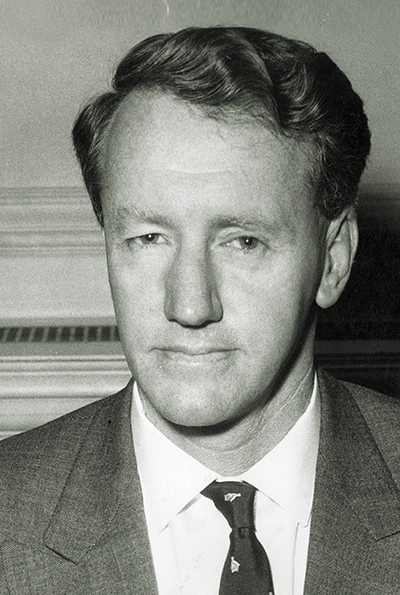
Coey’s death came in the midst of the Cold War. Two years after the U.S. decision to cease direct involvement in Vietnam, communist forces had entered Saigon that April and claimed victory. Everyday citizens of Western and Eastern Europe lived in fear of a hot war between the United States and the Soviet Union. Then there was Africa. The continent, many of whose countries represented the last bastions of European colonial rule, was in turmoil. The old order crumbled as blacks, representing the overwhelming majority, rose to throw off the yoke of colonialism. The results were inevitable, the only question being whether the new governments would be democratic or communist.
Rhodesia (present-day Zimbabwe) was among the holdouts. The British South Africa Company had administered the region as Southern Rhodesia from the 1880s until 1923, when it became a self-governing British colony. In 1953, British administrators consolidated Southern Rhodesia and the protectorates of Northern Rhodesia and Nyasaland into the Federation of Rhodesia and Nyasaland. In 1960 Britain, like other European nations before it, declared its intention to grant independence to those of its African colonies that accepted the concept of majority rule. Three years later the Federation of Rhodesia and Nyasaland was dissolved, and in 1964 Northern Rhodesia became the independent state of Zambia, and Nyasaland became Malawi.
But Prime Minister Ian Smith refused to give up his power. On Nov. 11, 1965, Smith’s cabinet adopted a Unilateral Declaration of Independence (UDI), proclaiming Rhodesia’s status as a sovereign state wholly independent of the United Kingdom. The colonial government, argued whites in the capital of Salisbury, had proved its ability to run the country and to do so better than the inexperienced black governments of the newly independent neighboring states. Though Britain had a legal right to militarily quell the upstart Rhodesians, London instead chose to slap the breakaway colony with economic and political sanctions. The United Nations followed suit, issuing its own trade sanctions against the unrecognized government.
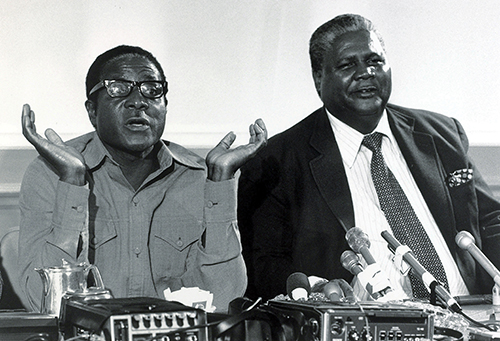
Resistance to the UDI and Rhodesia’s conservative white-minority administration was not limited to outside players, of course. Among prominent left-wing domestic opponents was trade unionist Joshua Nkomo and his Soviet-supported Zimbabwe African People’s Union (ZAPU), based in Zambia, whose Marxist armed wing was known as the Zimbabwe People’s Revolutionary Army (ZIPRA). Alternately supporting and opposing ZAPU was Robert Mugabe’s Chinese-supported Zimbabwe African National Union (ZANU) and its Maoist guerrilla wing, the Zimbabwe African National Liberation Army (ZANLA).
Though insurgents of both ZIPRA and ZANLA had launched low-level attacks and murder raids within Rhodesia even before the UDI, the Rhodesian Bush War began in earnest in 1966, as exiled guerrillas re-entering Rhodesia laid mines on roadways, attacked white-owned farms and ambushed the Smith government’s police and military patrols and outposts. Opposing the insurgents were conventional and special-operations elements of the Rhodesian army, as well as the paramilitary British South Africa Police (BSAP). The former included the all-white Rhodesian Light Infantry and Rhodesian Special Air Service (SAS), the all-black Rhodesian African Rifles (led by white officers) and the multiracial, multinational Selous Scouts (including black commissioned officers). In support of ground forces the Rhodesian Air Force employed fixed-wing attack and transport aircraft, as well as helicopters for troop-insertion and supply.
Rhodesian forces included both white and black soldiers, so their numbers were larger than one might expect, and they were able to function efficiently
One in a series of 20th-century wars ostensibly waged to stop the global spread of communism, the conflict in Rhodesia was in many respects atypical. There were no clear objectives, no ground or hills to take. It largely comprised a series of deadly “bush” battles between the forces of the white-minority government and those intent on overthrowing it. Both sides flouted time-honored rules of combat. Black militants slaughtered entire white families on the farms and ranches they attacked, just because they were white, while Rhodesian troops often set suspected guerrilla-aligned villages ablaze after a mission, regardless of how many militants they had encountered. There was certainly no love lost between the opposing factions.
The externally imposed sanctions failed to work for a range of reasons. For one, several nations flatly refused to observe them; South Africa and Portuguese Mozambique, among other countries, provided oil and other supplies to Rhodesia, and the United States continued to trade with the Smith government for strategic resources. Rhodesia also proved adept at both ramping up domestic production of various resources and smuggling in whatever else it needed. Many in the West were willing to lend a hand or at least look the other way over fear that should the Smith government fall, Rhodesia might become a communist state.
South Africa was far and away Rhodesia’s most prodigious provider of supplies. Its neighbor to the immediate south at first provided oil, arms, ammunition and other vital supplies. Soon it was providing personnel. In 1967, it deployed some 2,000 members of its national law enforcement agency, the South African Police (SAP), purportedly to guard Rhodesia’s northern border with Zambia. Despite appearances, the SAP units were not there to serve as border guards but to field-test and hone their own counterinsurgency procedures and tactics; lessons learned in Rhodesia led to development of the elite South African Police Service tactical unit. South Africa also loaned helicopters and pilots to Rhodesia for “police actions.”
By 1975, international pressure had opened a rift in the two nations’ relationship, as South African Prime Minister John “B.J.” Vorster, seeking to appease both black nationalist leaders in his own country as well as world leaders then meeting in Geneva, abruptly pulled all South African forces out of Rhodesia. A year later, the Vorster administration also stopped sending supplies to Rhodesia. Ironically, the South African government feared that an escalation in the fighting might prompt direct involvement by the Soviets and Cubans, though those communist states had been operating behind the scenes from the very beginning.
When the international talks in Geneva fell apart, South Africa restored its military aid, including aircraft. Among the South African leaders wholeheartedly supporting the Rhodesian cause was longtime Defense Minister P.W. Botha, who in 1978 succeeded Vorster as prime minister. Soon after he assumed office, large amounts of military equipment and troops (dressed in Rhodesian uniforms) crossed the border, including South African Reconnaissance Commandos aboard French-supplied Aérospatiale SA 330 Puma helicopters. Among other missions, these special operations units raided guerrilla bases in neighboring Mozambique, Zambia and Angola. South Africa also placed Dassault Mirage III fighters on standby in the event either Cuba or the Soviet Union sent MiG fighters to support the guerrillas.
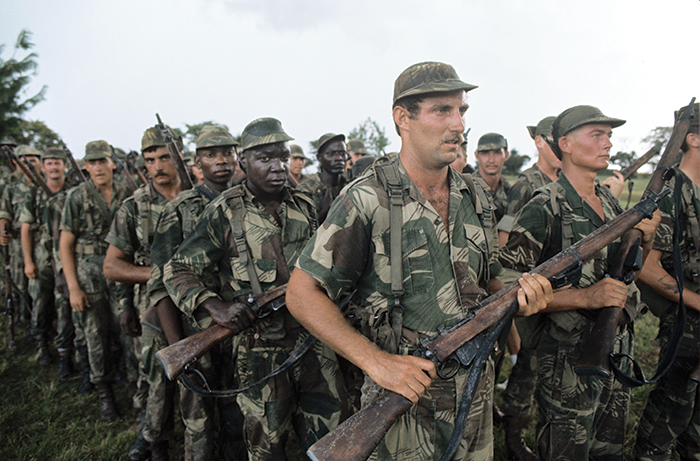
Despite its supply lines, one might wonder how a white minority that never numbered more than 275,000 was able to keep a civil war going in an African nation whose population exceeded 5 million. For one, the leading leftist opposition parties failed to unify. Second, Rhodesian forces included both white and black soldiers, so their numbers were larger than one might expect, and they were able to function efficiently. Third, as the war dragged on, Rhodesia supplemented its ranks by hiring significant numbers of mercenaries, many of whom were American.
In the mid-1970s, there was a great need for men of all ranks, particularly officers, to fill gaps in the Rhodesian army. Conscription of local whites was just not enough to meet the need. So the Rhodesian government began to actively recruit professional soldiers. In some cases, Rhodesian military officials made direct contact with candidates. More often than not, however, applicants responded to ads posted in numerous publications, notably Soldier of Fortune, which mounted an especially successful recruitment campaign on Rhodesia’s behalf. That magazine’s publisher, retired U.S. Army Green Beret Lt. Col. Robert Brown, even visited Salisbury in the summer of 1977 to discuss recruitment efforts with Rhodesian Maj. Nick Lamprecht.
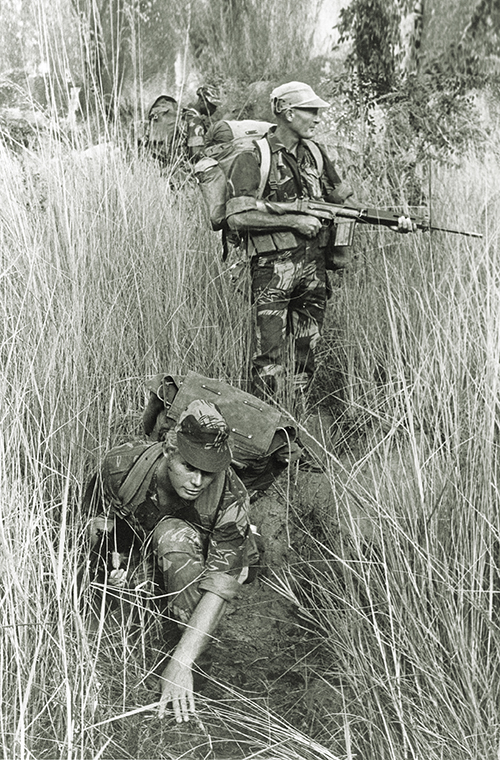
For its part the Rhodesian government insisted it did not hire “mercenaries,” claiming that any volunteers seeking to serve had to join its regular army. Rhodesia assigned many of them to semi-detached Protection Companies, assigned where needed to largely defensive and patrol duties. Pay for such “volunteers” or “immigrants” (Rhodesia refused to use the m-word) was modest to begin with but rose from $800 to as much as $3,000 a month. The number of foreigners fighting for Rhodesia numbered around 1,500, not counting South African troops. Most were either British or American. Other countries represented included West Germany, Ireland, Portugal, Canada, Australia, New Zealand and Denmark. The Rhodesian Light Infantry mainly comprised South African, West German and Danish mercenaries, though some 300 Americans also served in the unit. Both the Selous Scouts and mounted Grey’s Scouts included American and British mercenaries, many of whom served in the officer corps. Still, more Americans and Brits served in the Rhodesian special forces. Americans, notably Vietnam veterans, were especially coveted for their recent combat experience.
The ads in Soldier of Fortune and other publications proved especially appealing to such veterans (publisher Brown himself had served in Vietnam). Most recognized communism as a global threat and felt they hadn’t been allowed to fulfill their mission in Vietnam. Others were adventure junkies. Still others were motivated strictly by money. An undesirable few were supremacists who supported the continued white-minority rule of Rhodesia. “What we have here is an ideal core of white people who are able to raise the standard of living among the Africans,” one such recruit said. “Without us, conditions will decline rapidly.”
While researching his article “Vietnam Veterans in the Rhodesian Bush War,” in the March/April 2012 issue of The VVA Veteran, writer Xande Anderer asked former mercenary Richard Nelsen his motivation for joining the fight in Rhodesia. “Although the $1,000 a month he [Nelsen] would receive for his services was a definite enticement,” Anderer wrote, “he headed for Africa because he believed in the cause.” A Vietnam veteran using the alias “Donald Bachman” spoke of his motivation. “The U.S. had left Vietnam, and it fell to the communists,” he told Anderer. “Then Laos and Cambodia went. Here was another country under attack by communist guerrillas.”
Despite such willing combatants and the material support of South Africa, Rhodesia’s armed forces were outgunned, as the Soviets and Chinese provided the communist rebels a full range of arms, including heavy weapons. Rhodesian ground troops were limited to a hodgepodge of British Brens, Israeli Uzis, FNLs, AK-47s and RPG-7s (the latter two captured from the enemy). Fieldpieces centered on 60 mm and 81 mm mortars. So, using armored British Land Rovers and German Unimog trucks, the Rhodesian forces sought to take the fight to the enemy. Even as they redoubled their efforts in the field, a diplomatic solution was brewing.
The conflict in Rhodesia was in many respects atypical. There were no clear objectives, no ground or hills to take. It largely comprised a series of deadly “bush” battles between the forces of the white-minority government and those intent on overthrowing it
In 1976, a dozen years into the increasingly divisive Rhodesian Bush War, U.S. Secretary of State Henry Kissinger, South African President B.J. Vorster and British officials spearheaded negotiations between the Smith government and moderate black Rhodesian leaders aimed at ending the conflict, expanding black representation and transitioning the country to majority rule. On March 3, 1978, the parties signed an Internal Settlement mapping out that transition. The following spring United Methodist bishop and black nationalist Abel Muzorewa replaced Smith as interim prime minister of newly renamed Zimbabwe-Rhodesia. Shunning an offer of amnesty from the Muzorewa administration, the hard-line guerrilla forces, emboldened by the diplomatic shift, ramped up hostilities. The government responding by instituting martial law, essentially placing the country under the control of commander-in-chief Lt. Gen. Peter Walls and Ken Flower of the Central Intelligence Organization (the nation’s version of the CIA), who promptly stepped up raids into neighboring countries suspected of harboring guerrillas. At the same time government services, such as schools and clinics, came to a standstill in the isolated “native reserves,” where a majority of the black population lived.
The latter development sealed the fate of both the Bush War and the interim government, as Russian- and Cuban-backed guerrillas exploited the spreading discontent to recruit ever more disaffected blacks. The communist government of newly independent Mozambique, in support of ZANU/ZANLA, sent at least 500 regular troops into Rhodesia. A former member of the mercenary-led Selous Scouts saw the handwriting on the wall after mounting one 1979 raid into Mozambique. “We knew then that we could never beat them,” he recalled. “They had so much equipment, and there were so many of them. They would just keep coming with more and more.”
Using airmobile operations and air strikes, Rhodesian units, many led by American officers, continued to wage effective small-scale campaigns against the enemy. But in the end there were just too many of the enemy to stop.
The fighting finally wrapped up with the British-brokered Lancaster House Agreement, signed at that London landmark on Dec. 21, 1979, which enacted an immediate cease-fire. Under the terms of the agreement, Britain briefly assumed the political reins to oversee a path to lawful independence via free and open elections—including candidates from both ZANU and ZAPU. To ensure no violence or intimidation marred the process, guerrilla forces were to gather at designated assembly points under British supervision. As the newly elected government took power in April 1980, with Mugabe as prime minister and ZANU as the ruling party, most mercenaries—a price now on their heads—left the nation known since as Zimbabwe. Some returned home, while others headed to South Africa to offer their services there.
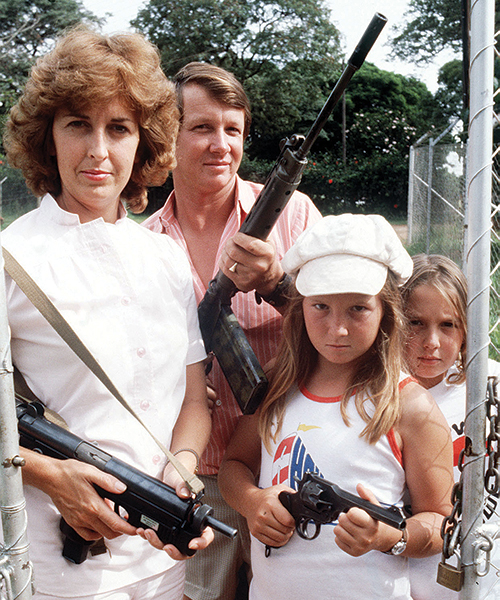
Meanwhile, the political, economic and human-rights situation in Zimbabwe went from bad to catastrophic. Within a decade Mugabe had assumed authoritarian rule of the nascent nation, largely under the thumb of his own party, while violently suppressing all opposition, particularly ZAPU and its supporters. Mugabe also went after the remaining white landowners. At the time of the transition whites represented 1 percent of the population yet owned 70 percent of the arable land. Seeking to rectify that discrepancy, the British-brokered agreement had provided a 10-year window for anyone willing to sell their land to Britain or the United States, the funds going toward reconciliation efforts. Almost immediately upon its expiration, Mugabe began to forcibly redistribute white-owned lands, allowing militants to invade and seize the farms. That in turn prompted a mass exodus of whites from Zimbabwe. A resulting decline in external financing, coupled with droughts and diminishing crop yields, led to a drastic drop in agricultural exports, which had represented the country’s leading economic sector.
The West responded to Mugabe’s land grab with crippling economic sanctions, and between 2000 and 2007 Zimbabwe’s economy shrank by half, its inflation rate soaring to 8,000 percent. Despite a massive increase in government spending on health care, living conditions deteriorated, the average life expectancy plummeted and an HIV/AIDS pandemic swept the country, affecting a quarter of the population. Unemployment and hunger ran rampant. Once one of Africa’s richest states, the failed state of Zimbabwe had become one of its poorest.
International pressure and widespread internal dissent finally ousted Mugabe, who was removed in a 2017 coup. After a narrow, vociferously contested 2018 election and a government-imposed 150 percent increase in fuel prices early this year, the jury is out on his ZANU successor, Emmerson Mnangagwa. Meanwhile, everyday Zimbabweans remain saddled with the wages of racial and ideological conflicts past and present. MH
U.S. Army veteran Dana Benner holds a master’s degree in heritage studies. He teaches history, political science and sociology at the university level. For further reading Benner recommends Merc: American Soldiers of Fortune, by Jay Mallin and Robert K. Brown, and Peasant Consciousness and Guerrilla War in Zimbabwe, by Terence Ranger.





